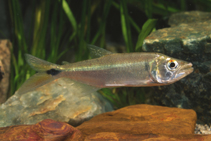Acestrorhynchus minimus Menezes, 1969
Upload your photos and videos
Pictures | Google imageAcestrorhynchus minimus
Picture by Hippocampus-Bildarchiv
Pictures | Google imageAcestrorhynchus minimus
Picture by Hippocampus-Bildarchiv
Classification / Names Nomi Comuni | Sinonimi | Catalog of Fishes(Genere, Specie) | ITIS | CoL | WoRMS | Cloffa
> Characiformes (Characins) > Acestrorhynchidae (Smallscale pike characins) > Acestrorhynchinae
Etymology: Acestrorhynchus: Greek, agkistron = hook + Greek, rhyngchos = snout (Ref. 45335).
Etymology: Acestrorhynchus: Greek, agkistron = hook + Greek, rhyngchos = snout (Ref. 45335).
Issue
See Menezes, 1969:78 for detailed description.
Environment: milieu / climate zone / depth range / distribution range Ecologia
; acqua dolce benthopelagico. Tropical
Distribuzione Stati | Aree FAO | Ecosystems | Presenze | Point map | Introduzioni | Faunafri
South America: Amazon and Orinoco River basins.
Size / Peso / Age
Short description Chiavi di identificazione | Morfologia | Morfometria
Differs from A. grandoculis and A. microlepis for lack of a small, dark spot behind the opercle. Scales on lateral line 74-85; scale rows between the lateral line and the dorsal fin 12-14. Distinguishable from the remaining Venezuelan congeners, except A. nasutus, by its small size up to 9.15 cm SL and by the presence of a narrow, dark line that extends from behind the opercle to about two thirds of the body length (Ref. 52916).
Life cycle and mating behavior Maturità | Riproduzione | Deposizione | Uova | Fecundity | Larve
Main reference
Upload your references | Bibliografia | Coordinatore | Collaboratori
Géry, J., 1977. Characoids of the world. Neptune City ; Reigate : T.F.H. [etc.]; 672 p. : ill. (chiefly col.) ; 23 cm. (Ref. 598)
IUCN Red List Status (Ref. 130435: Version 2024-2)
Least Concern (LC) ; Date assessed: 13 February 2020
CITES
Not Evaluated
Threat to humans
Harmless
Human uses
FAO - Publication: search | FishSource |
Informazioni ulteriori
Trophic ecology
Prede
Alimentazione
Consumo di cibo
Food rations
Predatori
Prede
Alimentazione
Consumo di cibo
Food rations
Predatori
Ecology
Ecologia
Ecologia
Population dynamics
Growth parameters
Max. ages / sizes
Length-weight rel.
Length-length rel.
Length-frequencies
Mass conversion
Reclutamento
Abbondanza
Growth parameters
Max. ages / sizes
Length-weight rel.
Length-length rel.
Length-frequencies
Mass conversion
Reclutamento
Abbondanza
Life cycle
Riproduzione
Maturità
Maturity/Gills rel.
Fecundity
Deposizione
Spawning aggregations
Uova
Egg development
Larve
Dinamica popolazioni larvali
Riproduzione
Maturità
Maturity/Gills rel.
Fecundity
Deposizione
Spawning aggregations
Uova
Egg development
Larve
Dinamica popolazioni larvali
Anatomy
Area branchiale
Brain
Otolith
Area branchiale
Brain
Otolith
Physiology
Body composition
Nutrients
Oxygen consumption
Swimming type
Swimming speed
Visual pigments
Fish sound
Diseases & Parasites
Toxicity (LC50s)
Body composition
Nutrients
Oxygen consumption
Swimming type
Swimming speed
Visual pigments
Fish sound
Diseases & Parasites
Toxicity (LC50s)
Genetics
Genetica
Heterozygosity
Ereditarietà
Genetica
Heterozygosity
Ereditarietà
Human related
Aquaculture systems
Profili di acquacoltura
Varietà
Ciguatera cases
Stamps, coins, misc.
Aquaculture systems
Profili di acquacoltura
Varietà
Ciguatera cases
Stamps, coins, misc.
Strumenti
E-book | Giuda pratica | Chiavi di identificazione | Generatore frequenze di lunghezza | Strumento Parametri Biologici | Mappa dei ritrovamenti | Classification Tree
| Catch-MSY |
Special reports
Download XML
Fonti Internet
AFORO (otoliths) | Aquatic Commons | BHL | Cloffa | BOLDSystems | Websites from users | Check FishWatcher | CISTI | Catalog of Fishes: Genere, Specie | DiscoverLife | ECOTOX | FAO - Publication: search | Faunafri | Fishipedia | Fishtrace | GenBank: genome, nucleotide | GloBI | Google Books | Google Scholar | Google | IGFA World Record | MitoFish | Otolith Atlas of Taiwan Fishes | PubMed | Reef Life Survey | Socotra Atlas | Tree of Life | Wikipedia: Go, ricerca | World Records Freshwater Fishing | Zoobank | Zoological Record
Estimates based on models
Phylogenetic diversity index (Ref. 82804): PD50 = 0.5001 [Uniqueness, from 0.5 = low to 2.0 = high].
Bayesian length-weight: a=0.00741 (0.00338 - 0.01626), b=3.08 (2.90 - 3.26), in cm total length, based on LWR estimates for this Genus-body shape (Ref. 93245).
Trophic level (Ref. 69278): 3.6 ±0.6 se; based on size and trophs of closest relatives
Fishing Vulnerability (Ref. 59153): Low vulnerability (10 of 100).




